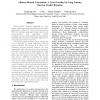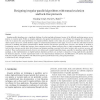102 search results - page 18 / 21 » Read-After-Read Memory Dependence Prediction |
ICS
2000
Tsinghua U.
13 years 11 months ago
2000
Tsinghua U.
As the performance gap between the CPU and main memory continues to grow, techniques to hide memory latency are essential to deliver a high performance computer system. Prefetchin...
HPCA
2008
IEEE
14 years 8 months ago
2008
IEEE
Hard-to-predict branches depending on longlatency cache-misses have been recognized as a major performance obstacle for modern microprocessors. With the widening speed gap between...
PDPTA
2000
13 years 9 months ago
2000
Exploiting compile time knowledge to improve memory bandwidth can produce noticeable improvements at run-time [13, 1]. Allocating the data structure [13] to separate memories when...
JPDC
2006
13 years 7 months ago
2006
Irregular parallel algorithms pose a significant challenge for achieving high performance because of the difficulty predicting memory access patterns or execution paths. Within an...
CORR
2008
Springer
13 years 7 months ago
2008
Springer
Abstract.1 The scheme of the sliding window is known in Information Theory, Computer Science, the problem of predicting and in stastistics. Let a source with unknown statistics gen...


